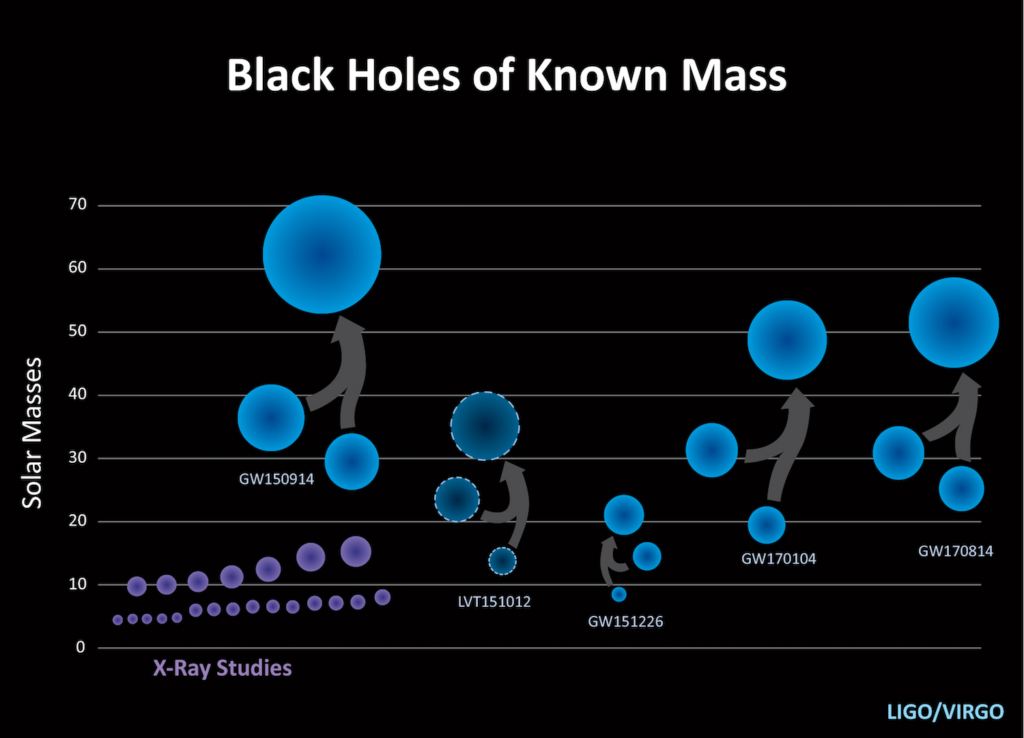On September 27, 2017, the Virgo Collaboration and the LIGO Scientific Collaboration announced the first gravitational-wave signal observed by a network of three laser interferometers. The detected gravitational wave was observed on August 14, 2017 and was produced by a pair of merging black holes with 31 and 25 solar masses.

Comparison of gravitational-wave signal templates from recent LIGO/Virgo observations. This figure shows reconstructions of the four confident and one candidate (LVT151012) gravitational wave signals detected by LIGO and Virgo to date, including the most recent detection GW170814 (which was observed in all three detectors). Each row shows the signal arriving at the Hanford detector as a function of time. The thickness of the curves indicates the 90% confidence interval on the model parameters. Only the portion of each signal that LIGO was sensitive to is shown here (the final seconds leading up to the black hole merger). [Credit: LIGO/Virgo/B. Farr (University of Oregon)]
Publications & Documentation
- Publication: GW170814 : A three-detector observation of gravitational waves from a binary black hole coalescence – published in Physical Review Letters 119, 141101 (2017). [local pdf link] [link to arXiv version]. [Link to companion paper.]
- LSC Press Release (also in Hindi | Spanish).
- Science Summary [pdf flyer]. Also translations in French | German | Italian | Polish | Spanish.
- Data release for GW170814 (LIGO Open Science Center/LOSC).
- GW170814 Factsheet [translations and Infographic [translations].
- Additional information at the LIGO Lab GW170814 detection website.
- See the main ligo.org detection page for further resources.

Skymap of the LIGO/Virgo black hole mergers. This three-dimensional projection of the Milky Way galaxy onto a transparent globe shows the probable locations of the three confirmed black-hole merger events observed by the two LIGO detectors—GW150914 (dark green), GW151226 (blue), GW170104 (magenta)—and a fourth confirmed detection (GW170814, light green, lower-left) that was observed by Virgo and the LIGO detectors. Also shown (in orange) is the lower significance event, LVT151012. The outer contour for each represents the 90 percent confidence region; the innermost contour signifies the 10 percent confidence region. The addition of Virgo shows a dramatic increase in the sky localization. [Image credit: LIGO/Virgo/Caltech/MIT/Leo Singer (Milky Way image: Axel Mellinger)]
Visualization from a numerical simulation of the gravitational waves and merger of orbiting black holes consistent with the masses of GW170814. The spheres at the center represent the event horizons of the black holes. The size of the black holes has been increased by a factor of 4 to enhance visibility. Elevation and color of the surface indicates the strength of the gravitational field at that point. Orange is strongest, dark blue is weakest. The cutout in the center is to avoid displaying the strong gravitational field near the black holes and hiding the waves. The simulation spans approximately 0.45 seconds of real time. Still images from this simulation can be found here.
[Credits: Numerical simulation: R. Haas, E. Huerta (University of Illinois). Visualization: R. Haas (University of Illinois). Copyright: The Board of Trustees of the University of Illinois]
Images & Videos
Numerical simulation showing the coalescence of two orbiting black holes as detected by the Advanced LIGO and Advanced Virgo observatories on 14 August 2017. The strength of the gravitational wave is indicated by elevation as well as color, with dark green indicating weak fields and bright violet indicating strong fields. The amplitude of the gravitational wave is rescaled in time, which allows showing the signal during the entire coalescence and not just close to merger, where it is strongest. Additionally, the sizes of the black holes are increased by a factor of two to improve visibility.
[Credits: Numerical Simulation: S. Ossokine, A. Buonanno (Max Planck Institute for Gravitational Physics), Simulating eXtreme Spacetimes project; Scientific Visualisation: T. Dietrich (Max Planck Institute for Gravitational Physics), R. Haas (NCSA)]

New Population of Binary Black Holes. LIGO and VIRGO have discovered a new population of black holes with masses that are larger than what had been seen before with X-ray studies alone (purple). The three previously confirmed detections by LIGO (GW150914, GW151226, GW170104), plus one lower-confidence detection (LVT151012), are shown along with the fourth confirmed detection (GW170814); the latter was observed by Virgo and both LIGO observatories. These point to a population of stellar-mass binary black holes that, once merged, are larger than 20 solar masses—larger than what was known before. [Image credit: LIGO/Caltech/Sonoma State (Aurore Simonnet)]

Still image from above numerical simulation showing the coalescence of two orbiting black holes as detected by the Advanced LIGO and Advanced Virgo observatories on 14 August 2017. The strength of the gravitational wave is indicated by elevation as well as color, with dark green indicating weak fields and bright violet indicating strong fields. The amplitude of the gravitational wave is rescaled in time, which allows showing the signal during the entire coalescence and not just close to merger, where it is strongest. Additionally, the sizes of the black holes are increased by a factor of two to improve visibility.
[Credits: Numerical Simulation: S. Ossokine, A. Buonanno (Max Planck Institute for Gravitational Physics), Simulating eXtreme Spacetimes project; Scientific Visualisation: T. Dietrich (Max Planck Institute for Gravitational Physics), R. Haas (NCSA)]

